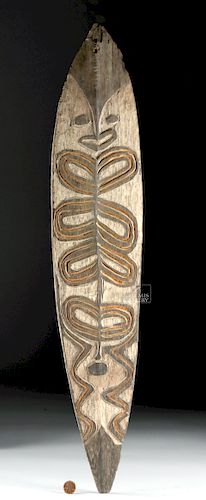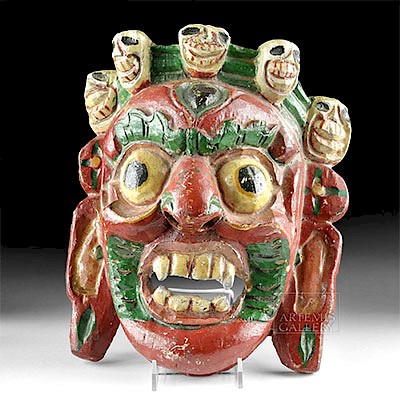Papua New Guinea Carved & Painted Wood Bullroarer
Lot 175a
About Seller
Artemis Gallery
686 S Taylor Ave, Ste 106
Louisville, CO 80027
United States
Selling antiquities, ancient and ethnographic art online since 1993, Artemis Gallery specializes in Classical Antiquities (Egyptian, Greek, Roman, Near Eastern), Asian, Pre-Columbian, African / Tribal / Oceanographic art. Our extensive inventory includes pottery, stone, metal, wood, glass and textil...Read more
Estimate:
$700 - $1,050
Absentee vs Live bid
Two ways to bid:
- Leave a max absentee bid and the platform will bid on your behalf up to your maximum bid during the live auction.
- Bid live during the auction and your bids will be submitted real-time to the auctioneer.
Bid Increments
| Price | Bid Increment |
|---|---|
| $0 | $25 |
| $300 | $50 |
| $1,000 | $100 |
| $2,000 | $250 |
| $5,000 | $500 |
| $10,000 | $1,000 |
| $20,000 | $2,500 |
| $50,000 | $5,000 |
| $100,000 | $10,000 |
| $200,000 | $20,000 |
About Auction
By Artemis Gallery
Apr 25, 2019
Set Reminder
2019-04-25 10:00:00
2019-04-25 10:00:00
America/New_York
Bidsquare
Bidsquare : Pre-Columbian | Tribal | Ethnographic
https://www.bidsquare.com/auctions/artemis-gallery/pre-columbian-tribal-ethnographic-4035
Featuring ancient and ethnographic art from around the world, including Pre-Columbian, Native American, African / Tribal, Ethnographic, Spanish Colonial, Fossils, Fine Art, much more. Artemis Gallery info@artemisgallery.com
Featuring ancient and ethnographic art from around the world, including Pre-Columbian, Native American, African / Tribal, Ethnographic, Spanish Colonial, Fossils, Fine Art, much more. Artemis Gallery info@artemisgallery.com
- Lot Description
Australia, Papua New Guinea, Upper Sepik, ca. late 19th to early 20th century CE. A hardwood bull roarer - an aerophone in the form of a thin blade that makes a roaring (hence the name), howling sound when whirled through the air on a cord threaded through the perforation at one end. The piece is meticulously hand-carved and painted with organic pigments of red, brown, and white hues. As is traditional, this example presents abstract visages and curvilinear motifs. According to the Metropolitan Museum of Art in New York curatorial team, "In Papua New Guinea, bullroarers hold a traditional place of honor in men’s ceremonial clubhouses. The Namau people of the Purari River Delta used them during funerals of important men and called them imunu viki ("weeping spirits"). " (https://www.metmuseum.org/art/collection/search/504985) Size: 26.5" L x 5.375" W (67.3 cm x 13.7 cm)
This ancient instrument customarily consists of an oblong slat of wood with a hole at end through which a long string is tied. When the slat is rapidly swung in a circular motion through the air it rotates on its long axis to created a whirring sound. In some regions of the Pacific, bullroarers are secular instruments or children's toys; however, for many peoples they have traditionally been and continue to be ritual objects.
Provenance: ex-old private New England, USA collection, acquired in the 1970s; ex-private Florida, USA collection
All items legal to buy/sell under U.S. Statute covering cultural patrimony Code 2600, CHAPTER 14, and are guaranteed to be as described or your money back.
A Certificate of Authenticity will accompany all winning bids.
We ship worldwide and handle all shipping in-house for your convenience.
#140543Normal surface wear, wear/abrasions to peripheries, and some fading to pigments, commensurate with age.Condition
- Shipping Info
-
All shipping is handled in-house for your convenience. Your invoice from Artemis Gallery will include shipping calculation instructions. If in doubt, please inquire BEFORE bidding for estimated shipping costs for individual items.
-
- Buyer's Premium



 EUR
EUR CAD
CAD AUD
AUD GBP
GBP MXN
MXN HKD
HKD CNY
CNY MYR
MYR SEK
SEK SGD
SGD CHF
CHF THB
THB













